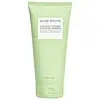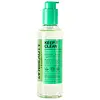What's inside
What's inside
 Key Ingredients
Key Ingredients

 Benefits
Benefits

 Concerns
Concerns

 Ingredients Side-by-side
Ingredients Side-by-side

Water
Skin ConditioningGlycerin
HumectantSodium Cocoyl Alaninate
Sodium Methyl Cocoyl Taurate
CleansingAcrylates/C10-30 Alkyl Acrylate Crosspolymer
Emulsion StabilisingInulin
Skin ConditioningButylene Glycol
HumectantCeramide NP
Skin ConditioningColloidal Oatmeal
AbsorbentCaprylyl Glycol
EmollientLauryl Hydroxysultaine
CleansingCoco-Glucoside
CleansingSodium Hyaluronate
HumectantPersea Gratissima Oil
Skin ConditioningPersea Gratissima Fruit Extract
EmollientSaccharide Isomerate
HumectantMicrococcus Lysate
Skin ConditioningGlyceryl Caprylate
EmollientPolyglyceryl-10 Laurate
Skin ConditioningStyrene/Acrylates Copolymer
Sodium Cocoyl Isethionate
Cleansing1,2-Hexanediol
Skin ConditioningEpidermidibacterium Keratini Ferment Filtrate
EmollientQuillaja Saponaria Bark Extract
CleansingSodium Phytate
Lecithin
EmollientDipotassium Glycyrrhizate
HumectantCitric Acid
BufferingMoringa Oleifera Seed Oil
EmollientSodium Citrate
BufferingButyl Avocadate
Skin ConditioningArginine
MaskingPhytosphingosine
Skin ConditioningHydrogenated Lecithin
EmulsifyingHydroxypropyltrimonium Hyaluronate
Mannose
HumectantHydrolyzed Hyaluronic Acid
HumectantSodium Acetylated Hyaluronate
HumectantMaltodextrin
AbsorbentTocopherol
AntioxidantHyaluronic Acid
HumectantHydrolyzed Sodium Hyaluronate
Skin ConditioningSodium Hyaluronate Crosspolymer
HumectantPotassium Hyaluronate
Skin ConditioningXanthan Gum
EmulsifyingAloe Ferox Leaf Extract
Skin ConditioningHexylene Glycol
EmulsifyingTriacetin
AntimicrobialGardenia Florida Fruit Extract
Skin ConditioningDextrin
AbsorbentParfum
MaskingWater, Glycerin, Sodium Cocoyl Alaninate, Sodium Methyl Cocoyl Taurate, Acrylates/C10-30 Alkyl Acrylate Crosspolymer, Inulin, Butylene Glycol, Ceramide NP, Colloidal Oatmeal, Caprylyl Glycol, Lauryl Hydroxysultaine, Coco-Glucoside, Sodium Hyaluronate, Persea Gratissima Oil, Persea Gratissima Fruit Extract, Saccharide Isomerate, Micrococcus Lysate, Glyceryl Caprylate, Polyglyceryl-10 Laurate, Styrene/Acrylates Copolymer, Sodium Cocoyl Isethionate, 1,2-Hexanediol, Epidermidibacterium Keratini Ferment Filtrate, Quillaja Saponaria Bark Extract, Sodium Phytate, Lecithin, Dipotassium Glycyrrhizate, Citric Acid, Moringa Oleifera Seed Oil, Sodium Citrate, Butyl Avocadate, Arginine, Phytosphingosine, Hydrogenated Lecithin, Hydroxypropyltrimonium Hyaluronate, Mannose, Hydrolyzed Hyaluronic Acid, Sodium Acetylated Hyaluronate, Maltodextrin, Tocopherol, Hyaluronic Acid, Hydrolyzed Sodium Hyaluronate, Sodium Hyaluronate Crosspolymer, Potassium Hyaluronate, Xanthan Gum, Aloe Ferox Leaf Extract, Hexylene Glycol, Triacetin, Gardenia Florida Fruit Extract, Dextrin, Parfum
Water
Skin ConditioningGlycerin
HumectantSodium C14-16 Olefin Sulfonate
CleansingCocamidopropyl Betaine
CleansingSodium Chloride
MaskingCeramide NP
Skin ConditioningGlucosyl Ceramide
Skin ConditioningArginine
MaskingProline
Skin ConditioningSerine
MaskingAlanine
MaskingGlycine
BufferingLysine Hcl
Skin ConditioningThreonine
Collagen
MoisturisingCentella Asiatica Extract
CleansingCucumis Sativus Fruit Extract
EmollientPyrus Malus Fruit Extract
Skin ConditioningRosa Damascena Flower Extract
MaskingCamellia Sinensis Leaf Extract
AntimicrobialBetaine
HumectantPelargonium Graveolens Extract
MaskingMelia Azadirachta Leaf Extract
Skin ConditioningCurcuma Longa Root Extract
MaskingBoerhavia Diffusa Root Extract
Skin ProtectingMelia Azadirachta Flower Extract
Skin ConditioningAlpha-Glucan
HumectantSodium PCA
HumectantPCA
HumectantPullulan
Citrus Aurantium Bergamia Fruit Oil
MaskingCitrus Nobilis Peel Oil
MaskingHydrogenated Lecithin
EmulsifyingSucrose Stearate
EmollientGlutamic Acid
HumectantPolyglyceryl-10 Stearate
Skin ConditioningSorbitan Oleate Decylglucoside Crosspolymer
CleansingDecyl Glucoside
CleansingCaprylyl Glycol
Emollient1,2-Hexanediol
Skin ConditioningButylene Glycol
HumectantSodium Lactate
BufferingSodium Lauroyl Sarcosinate
CleansingHydroxyacetophenone
AntioxidantCitric Acid
BufferingSodium Lauroyl Lactylate
EmulsifyingSodium Phytate
Water, Glycerin, Sodium C14-16 Olefin Sulfonate, Cocamidopropyl Betaine, Sodium Chloride, Ceramide NP, Glucosyl Ceramide, Arginine, Proline, Serine, Alanine, Glycine, Lysine Hcl, Threonine, Collagen, Centella Asiatica Extract, Cucumis Sativus Fruit Extract, Pyrus Malus Fruit Extract, Rosa Damascena Flower Extract, Camellia Sinensis Leaf Extract, Betaine, Pelargonium Graveolens Extract, Melia Azadirachta Leaf Extract, Curcuma Longa Root Extract, Boerhavia Diffusa Root Extract, Melia Azadirachta Flower Extract, Alpha-Glucan, Sodium PCA, PCA, Pullulan, Citrus Aurantium Bergamia Fruit Oil, Citrus Nobilis Peel Oil, Hydrogenated Lecithin, Sucrose Stearate, Glutamic Acid, Polyglyceryl-10 Stearate, Sorbitan Oleate Decylglucoside Crosspolymer, Decyl Glucoside, Caprylyl Glycol, 1,2-Hexanediol, Butylene Glycol, Sodium Lactate, Sodium Lauroyl Sarcosinate, Hydroxyacetophenone, Citric Acid, Sodium Lauroyl Lactylate, Sodium Phytate
 Reviews
Reviews

Ingredients Explained
These ingredients are found in both products.
Ingredients higher up in an ingredient list are typically present in a larger amount.
1,2-Hexanediol is a synthetic liquid and another multi-functional powerhouse.
It is a:
- Humectant, drawing moisture into the skin
- Emollient, helping to soften skin
- Solvent, dispersing and stabilizing formulas
- Preservative booster, enhancing the antimicrobial activity of other preservatives
Arginine is an amino acid that is important for human development. Your body uses is it to produce hair keratin and skin collagen.
As a cosmetic ingredient, Arginine has antioxidant properties and can also help repair damaged skin. This ingredient is derived either synthetically or from animals.
Arginine isn't fungal acne safe when used in the presence of other lipids (fats, fatty acids, oils, esters, etc). Oils and fats occur naturally within the skin, so take caution when using Arginine if you're prone to fungal acne.
Learn more about ArginineButylene Glycol (or BG) is used within cosmetic products for a few different reasons:
Overall, Butylene Glycol is a safe and well-rounded ingredient that works well with other ingredients.
Though this ingredient works well with most skin types, some people with sensitive skin may experience a reaction such as allergic rashes, closed comedones, or itchiness.
Learn more about Butylene GlycolCaprylyl Glycol is a humectant and emollient, meaning it attracts and preserves moisture.
It is a common ingredient in many products, especially those designed to hydrate skin. The primary benefits are retaining moisture, skin softening, and promoting a healthy skin barrier.
Though Caprylyl Glycol is an alcohol derived from fatty acids, it is not the kind that can dry out skin.
This ingredient is also used as a preservative to extend the life of products. It has slight antimicrobial properties.
Learn more about Caprylyl GlycolCeramide NP is a type of ceramide.
Ceramides are intercellular lipids naturally found in our skin that bonds dead skin cells together to create a barrier. They are known for their ability to hold water and thus are a great ingredient for dry skin.
Ceramides are an important building block for our skin barrier. A stronger barrier helps the skin look more firm and hydrated. By bolstering the skin ceramides act as a barrier against irritating ingredients. This can help with inflammation as well.
If you would like to eat ceramides, sweet potatoes contain a small amount.
Read more about other common types of ceramides here:
Ceramide AP
Ceramide EOP
Citric Acid is an alpha hydroxy acid (AHA) naturally found in citrus fruits like oranges, lemons, and limes.
Like other AHAs, citric acid can exfoliate skin by breaking down the bonds that hold dead skin cells together. This helps reveal smoother and brighter skin underneath.
However, this exfoliating effect only happens at high concentrations (20%) which can be hard to find in cosmetic products.
Due to this, citric acid is usually included in small amounts as a pH adjuster. This helps keep products slightly more acidic and compatible with skin's natural pH.
In skincare formulas, citric acid can:
While it can provide some skin benefits, research shows lactic acid and glycolic acid are generally more effective and less irritating exfoliants.
Most citric acid used in skincare today is made by fermenting sugars (usually from molasses). This synthetic version is identical to the natural citrus form but easier to stabilize and use in formulations.
Read more about some other popular AHA's here:
Learn more about Citric AcidGlycerin is already naturally found in your skin. It helps moisturize and protect your skin.
A study from 2016 found glycerin to be more effective as a humectant than AHAs and hyaluronic acid.
As a humectant, it helps the skin stay hydrated by pulling moisture to your skin. The low molecular weight of glycerin allows it to pull moisture into the deeper layers of your skin.
Hydrated skin improves your skin barrier; Your skin barrier helps protect against irritants and bacteria.
Glycerin has also been found to have antimicrobial and antiviral properties. Due to these properties, glycerin is often used in wound and burn treatments.
In cosmetics, glycerin is usually derived from plants such as soybean or palm. However, it can also be sourced from animals, such as tallow or animal fat.
This ingredient is organic, colorless, odorless, and non-toxic.
Glycerin is the name for this ingredient in American English. British English uses Glycerol/Glycerine.
Learn more about GlycerinHydrogenated Lecithin is created from the hydrogenation of lecithin (a group of phospholipids). Hydrogenation is a chemical reaction between hydrogen and another element.
This ingredient is an emollient and emulsifier. As an emollient, it helps soften skin by trapping moisture within. As an emulsifier, it prevents oil and water ingredients from separating.
Sodium Phytate is the synthetic salt form of phytic acid. Phytic acid is an antioxidant and can be found in plant seeds.
Sodium Phytate is a chelating agent. Chelating agents help prevent metals from binding to water. This helps stabilize the ingredients and the product.
Water. It's the most common cosmetic ingredient of all. You'll usually see it at the top of ingredient lists, meaning that it makes up the largest part of the product.
So why is it so popular? Water most often acts as a solvent - this means that it helps dissolve other ingredients into the formulation.
You'll also recognize water as that liquid we all need to stay alive. If you see this, drink a glass of water. Stay hydrated!
Learn more about Water